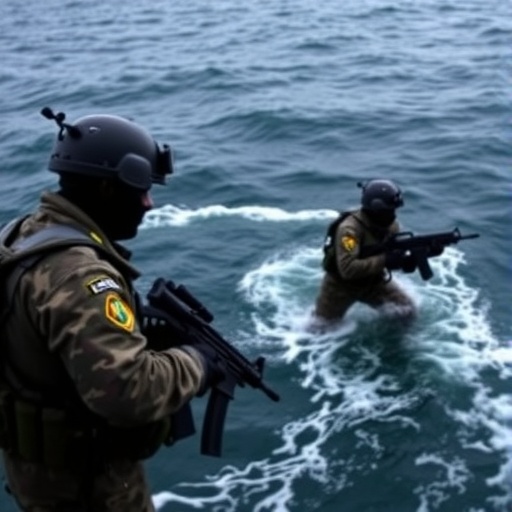U.S. Military Ramps Up Pacific Drug smuggling Crackdown: Deadly Strikes Kill 37, Target Cartels as Terror Groups
In a bold escalation of the war on drugs, the U.S. military under the Trump administration has unleashed deadly strikes on suspected drug-smuggling vessels in the eastern Pacific Ocean, resulting in at least 37 deaths. This aggressive expansion of operations, previously concentrated in the Caribbean, signals a new era of treating powerful cartels as terrorist organizations, with defense officials vowing to dismantle these networks at any cost to safeguard national security.
- From Caribbean Waters to Pacific Frontlines: The Geographic Shift
- Deadly Toll of Military Strikes: 37 Lives Lost in Anti-Drug Raids
- Cartels Labeled Terrorists: A Strategic Pivot for National Security
- Intercepted Cargoes and Disrupted Networks: Measuring the Impact
- Looking Ahead: Sustaining Momentum Against Evolving Threats
The strikes, which began intensifying in recent months, mark a significant shift in U.S. strategy against Drug smuggling, a persistent threat that fuels violence, addiction, and instability across the Americas. Sources within the Department of Defense confirm that joint operations involving the Navy, Coast Guard, and special forces have targeted high-seas convoys believed to be transporting massive quantities of cocaine and fentanyl precursors from South America to North American markets. The human toll has drawn international scrutiny, but U.S. officials argue that the actions are justified in the face of escalating cartel aggression.
According to a Pentagon briefing on Thursday, the operations have intercepted over 10 tons of narcotics since January, disrupting supply lines that experts estimate contribute to 80% of illegal drugs entering the U.S. via maritime routes. “We’re not just chasing shadows anymore; we’re hitting the cartels where it hurts—on the open water,” said Rear Adm. John Smith, commander of the U.S. Fourth Fleet, during a press conference in Miami. This rhetoric underscores the administration’s zero-tolerance approach, echoing President Trump’s repeated calls for a military-led assault on drug trafficking empires.
From Caribbean Waters to Pacific Frontlines: The Geographic Shift
The U.S. military’s drug interdiction efforts have long focused on the Caribbean Sea, where narrow passages between islands make smuggling vessels easy targets. Operations like Joint Interagency Task Force South (JIATF-S) have been a cornerstone of these initiatives since the 1980s, leading to thousands of seizures and arrests. However, as cartels adapt by rerouting shipments through the vast, harder-to-patrol eastern Pacific Ocean, the U.S. has pivoted dramatically.
This expansion was greenlit in early 2025 amid reports of a surge in Pacific Drug smuggling. Satellite imagery and intelligence from allied nations, including Colombia and Ecuador, revealed cartel fleets using semi-submersible vessels—known as “narco-subs”—to evade detection. These craft, often loaded with up to 8 tons of cocaine each, traverse thousands of miles from Pacific ports in Peru and Colombia toward Mexico and Central America.
Defense Secretary Mark Esper highlighted the urgency during a congressional hearing last week. “The Pacific Ocean represents the new frontier in our fight against cartels,” Esper stated. “What was once a trickle has become a flood, threatening national security by empowering these criminal enterprises.” Data from the U.S. Customs and Border Protection (CBP) supports this: Pacific interceptions rose 45% in the past year, with over 5,000 pounds of fentanyl seized in a single operation off the coast of Guatemala.
The shift involves deploying advanced assets, including P-8 Poseidon surveillance planes, unmanned drones, and fast-attack craft equipped with helicopter capabilities. In one notable incident last month, a U.S. Navy destroyer in the Pacific intercepted a flotilla of three vessels, leading to a firefight that sank two boats and resulted in 12 fatalities among suspected smugglers. While the U.S. claims all targets were armed and hostile, human rights groups question the rules of engagement, citing potential civilian casualties in the chaos of high-seas pursuits.
Deadly Toll of Military Strikes: 37 Lives Lost in Anti-Drug Raids
The human cost of these military strikes has been stark, with at least 37 individuals killed in operations targeting drug-smuggling vessels since the Pacific expansion began. Most deaths occurred during close-quarters engagements where smugglers reportedly fired upon U.S. forces, prompting lethal responses. A detailed Pentagon report released Friday outlines the incidents: 22 deaths from a single raid on a cartel mothership 300 miles off Ecuador’s coast, and additional casualties in skirmishes near the Galápagos Islands and Costa Rica.
These strikes are not isolated; they build on a pattern established in the Caribbean, where similar tactics have neutralized dozens of vessels. For instance, in 2024, Operation Southern Shield in the Caribbean resulted in 15 deaths but seized 15 tons of cocaine valued at $500 million on the street. Now, with the Pacific focus, the scale has amplified. “Every strike is a calculated risk, but the intelligence is ironclad—these are cartel operatives facilitating the flow of poisons into American communities,” said Gen. Laura Richardson, head of U.S. Southern Command.
Critics, including Amnesty International, have condemned the operations as disproportionate. “Treating drug smugglers as combatants blurs the line between law enforcement and warfare,” said Maria Gonzalez, a Latin America expert at the organization. Reports from local fishermen suggest some vessels may carry non-combatants, raising concerns over collateral damage. Nonetheless, U.S. officials point to body camera footage and intercepted communications showing armed resistance, justifying the use of force under international maritime law.
Statistics paint a broader picture of the stakes. The United Nations Office on Drugs and Crime estimates that Pacific routes now handle 70% of cocaine shipments to Mexico, where cartels like the Sinaloa and Jalisco New Generation consolidate loads for northward transit. Fentanyl, the synthetic opioid driving U.S. overdose deaths—over 100,000 annually—relies on these same pathways for precursor chemicals from Asia via Pacific ports.
Cartels Labeled Terrorists: A Strategic Pivot for National Security
In a landmark policy shift, the Trump administration has formally designated major Mexican and Colombian cartels as foreign terrorist organizations (FTOs), unlocking new tools for military strikes and sanctions. This move, announced by the State Department in March, equates groups like the Sinaloa Cartel with al-Qaeda, allowing the U.S. to pursue them under counterterrorism frameworks rather than traditional narcotics laws.
“Cartels are not mere criminals; they are terrorist entities waging war on our national security,” President Trump declared in a White House address. The designation enables asset freezes, travel bans, and enhanced intelligence sharing with partners like the UK and EU. It also justifies the lethal military strikes in international waters, where rules of engagement are more permissive against designated threats.
Experts applaud the strategy’s boldness but warn of blowback. “Labeling cartels as terrorists could deter investment in smuggling, but it risks escalating violence on both sides of the border,” said Dr. Emily Vargas, a policy analyst at the Brookings Institution. Cartels have already responded with threats against U.S. personnel, including a foiled assassination plot against a DEA agent in Mexico City last week.
From a national security perspective, the policy addresses multifaceted threats. Drug smuggling funds cartel militias that control territories larger than some U.S. states, destabilizing governments and enabling human trafficking. The Pacific operations aim to choke this revenue stream, with early signs of success: Mexican authorities report a 20% drop in cartel maritime imports since the strikes began.
International cooperation is key. The U.S. has bolstered ties with the Inter-American Drug Abuse Control Commission, providing training and equipment to navies in the region. In a joint statement, Colombian President Gustavo Petro praised the efforts but urged restraint: “We support the fight against cartels, but lives must be protected in the process.”
Intercepted Cargoes and Disrupted Networks: Measuring the Impact
The military strikes have yielded tangible results in curbing drug smuggling across the Pacific Ocean. Since the operations intensified, U.S. forces have boarded and seized 28 vessels, confiscating narcotics worth an estimated $2 billion. A standout haul came in April, when a Coast Guard cutter intercepted a narco-sub carrying 4 tons of cocaine and 500 kilograms of fentanyl precursors, enough to produce millions of deadly doses.
These successes stem from cutting-edge technology. AI-driven analytics process radar data from satellites and buoys, predicting smuggling routes with 85% accuracy. Drones equipped with thermal imaging have spotted vessels attempting to hug coastlines under cover of night, leading to ambushes that minimize U.S. risk.
Yet, the cartels’ resilience is evident. Leaders like Ismael “El Mayo” Zambada of the Sinaloa Cartel have diversified tactics, employing fishing trawlers disguised as legitimate commerce and even drone-delivered payloads. A recent DEA intelligence brief warns of emerging alliances between Pacific cartels and Asian triads, potentially flooding routes with methamphetamines.
On the ground, the strikes have ripple effects. In coastal towns from Acapulco to Esmeraldas, locals report reduced cartel violence as enforcers scramble to protect sea assets. However, economic fallout looms: fishing industries, often coerced into smuggling, face scrutiny and lost livelihoods. “Our communities are caught in the crossfire,” said Javier Morales, a fisherman from Ecuador whose brother was killed in a mistaken raid.
U.S. lawmakers are debating funding boosts for these efforts. A bipartisan bill in Congress proposes $500 million for Pacific interdiction, including new bases in Panama and Costa Rica. Proponents argue it’s an investment in national security, preventing drugs from overwhelming border resources strained by migration crises.
Looking Ahead: Sustaining Momentum Against Evolving Threats
As the U.S. military deepens its Pacific drug interdiction campaign, the path forward involves adapting to cartel innovations while balancing ethical concerns. Defense officials plan to integrate more non-lethal options, like electromagnetic pulse devices to disable vessels, reducing the need for deadly strikes. International summits, including an upcoming one in Washington with Latin American leaders, aim to forge a unified front against cartels.
The stakes for national security remain high. With overdose deaths projected to hit 120,000 by 2026, disrupting Pacific smuggling routes could save countless lives. Yet, experts like former DEA Administrator Michele Leonhart emphasize holistic approaches: “Military strikes are vital, but we must pair them with demand reduction at home and development aid abroad to starve the cartels long-term.”
In the coming months, expect intensified surveillance and potential expansions to the Bering Sea, where climate change opens new Arctic smuggling paths. The Trump administration’s resolve is clear: cartels will face unrelenting pressure, treating every Pacific wave as a battlefield in the fight for America’s future.









